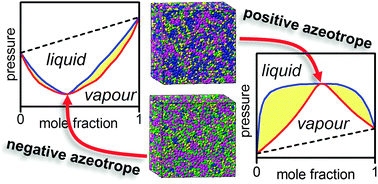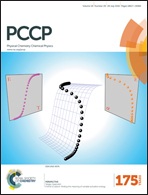Microstructures of negative and positive azeotropes†
Abstract
Azeotropes famously impose fundamental restrictions on distillation processes, yet their special thermodynamic properties make them highly desirable for a diverse range of industrial and technological applications. Using neutron diffraction, we investigate the structures of two prototypical azeotropes, the negative acetone–chloroform and the positive benzene–methanol azeotrope. C–H⋯O hydrogen bonding is the dominating interaction in the negative azeotrope but C–Cl⋯O halogen bonding contributes as well. Hydrogen-bonded chains of methanol molecules, which are on average longer than in pure methanol, are the defining structural feature of the positive azeotrope illustrating the fundamentally different local mixing in the two kinds of azeotropes. The emerging trend for both azeotropes is that the more volatile components experience the more pronounced structural changes in their local environments as the azeotropes form. The mixing of the acetone–chloroform azeotrope is essentially random above 20 Å, where the running Kirkwood–Buff integrals of our structural model converge closely to the ones expected from thermodynamic data. The benzene–methanol azeotrope on the other hand displays extended methanol-rich regions and consequently the running Kirkwood–Buff integrals oscillate up to at least 60 Å. Our study provides the first experimental insights into the microstructures of azeotropes and a direct link with their thermodynamic properties. Ultimately, this will provide a route for creating tailored molecular environments in azeotropes to improve and fine-tune their performances.


 Please wait while we load your content...
Please wait while we load your content...